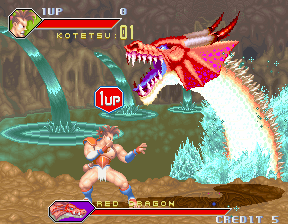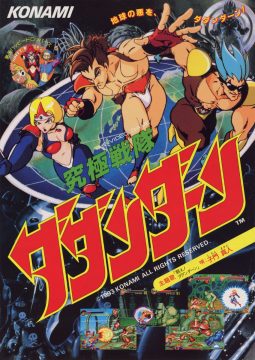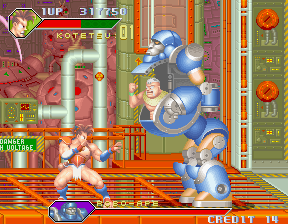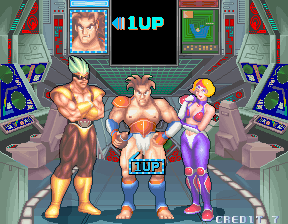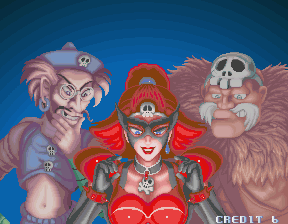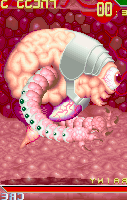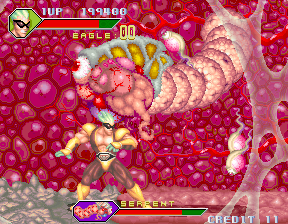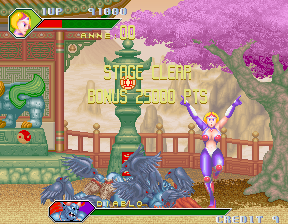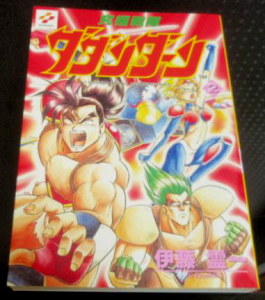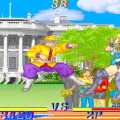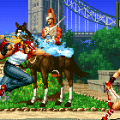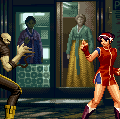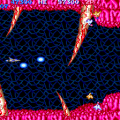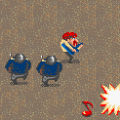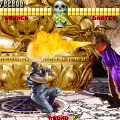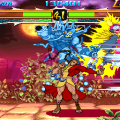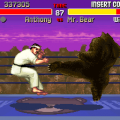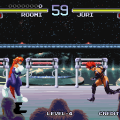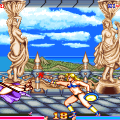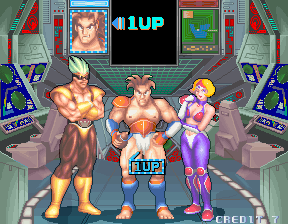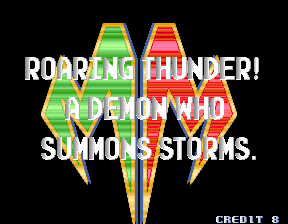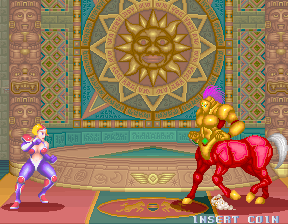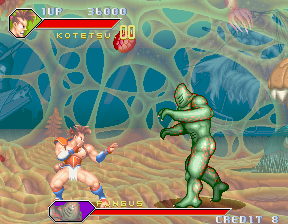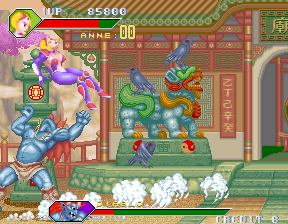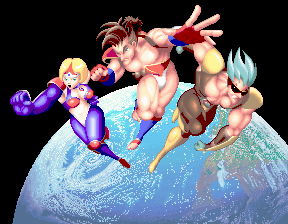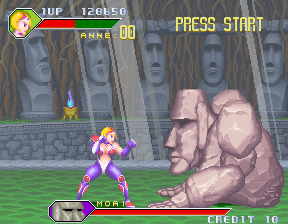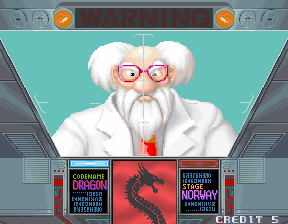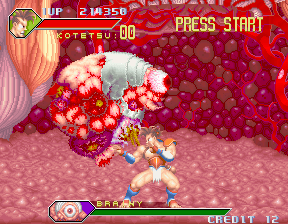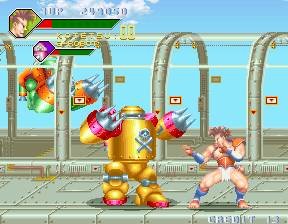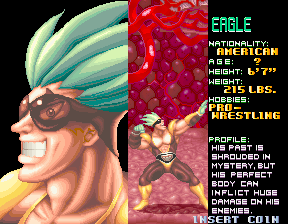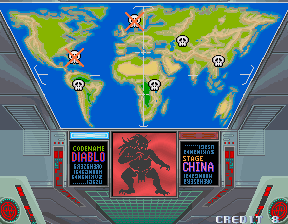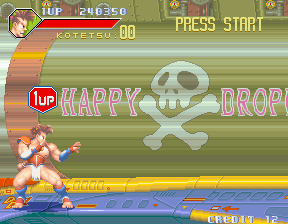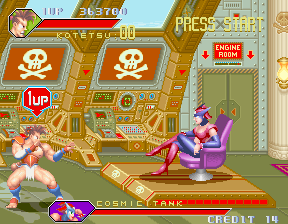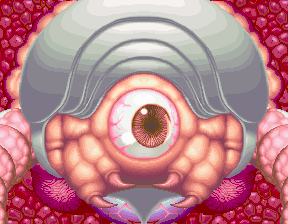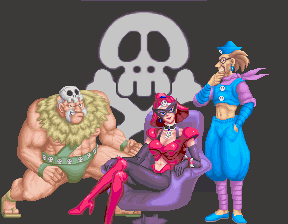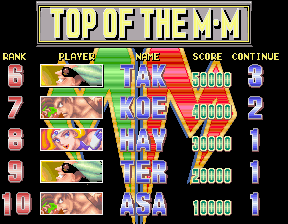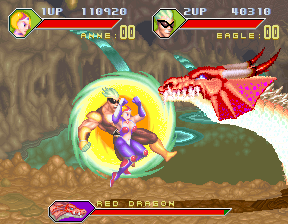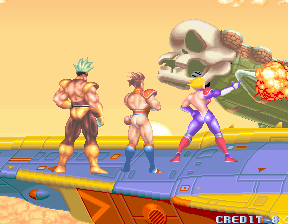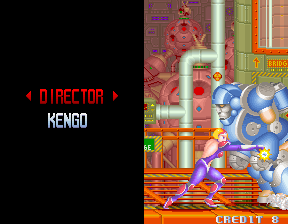When people think of Konami’s arcade titles, they tend to think (with good reason) of their famous licensed beat-em-ups – Teenage Mutant Ninja Turtles, X-Men, The Simpsons. In amongst these more well-known games were a few gems that went by almost unnoticed, including the 1993 brawler Monster Maulers, known is Japan as Kyukyoku Sentai Dadandarn (“Ultimate Squad Dadandarn”).
While almost all of Konami’s arcade fighters of the time were bold, colourful affairs, Monster Maulers is particularly over-the-top. The theme of the game is that it is a video game version of a Japanese tokusatsu or “Super Sentai” show: a live-action series where a group of costumed superheroes band together to fight monsters that are usually men in rubber suits. The best example of this for a western audience would of course be the Mighty Morphin’ Power Rangers, which was made from edited footage of the Super Sentai show Kyouryuu Sentai Zyuuranger.
Monster Maulers goes all-out to capture the Super Sentai ambience: it features a team of heroes who are given orders by an old scientist to defeat the monsters plaguing the Earth. Before each stage, a “title card” appears like it would at the start of an episode of a tokusatsu show, full of overblown and hot-blooded warnings of terrible danger like “Roaring Thunder! A Demon Who Summons Storms!”. The music is exactly what you would expect to hear in a Japanese monster-fighting show, all epic brass sections and wah-wah guitars. There’s even a vocal theme song called “Tatakae! Dadandarn!” (Fight! Dadandarn!) performed by Shimon Masato, a Japanese singer famous for performing the theme songs to such tokusatsu shows as Kamen Rider and Android Kikaider.
Despite the game’s thoroughly Japanese subject matter, little of the game was changed for the Western release. What differences there are are mostly cosmetic: Some of the monsters’ names were changed, and in the Japanese version Eagle’s nationality is listed as “unknown”, the “episode titles” are read aloud and the theme song is played during the first stage, whereas in the Western version it plays during the first area of the final stage. The only difference that impacts the gameplay is that in the Japanese version, one of the sub-bosses can be skipped if the stage containing it is chosen first.
As illustrated by the attract mode, Monster Maulers‘ plot is a very simple one. A trio of villains called “Happy Droppers” send a canister filled (in typical Super Sentai fashion) with monster eggs down to Earth. Witnessing the destruction caused by the newly-hatched monsters, three powerful heroes band together as the Dadandarn Squad and set out to defeat them. That’s all there is to the story, and all that’s left is to select one of the three playable characters and get into the action.
Characters
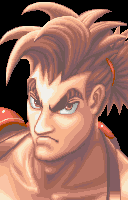
Kotetsu
Nationality: Japanese
Age: 29
Height: 6′ 8″
Weight: 165 lbs
Hobbies: Haiku, meditation.
The game’s balanced, all-round character, Kotetsu is a Japanese martial arts master who has combined various techniques into one deadly fighting style. His special moves are a fireball, the angle of which alters depending on the strength of the button pressed, and a Psycho Crusher-style human torpedo maneuver. Overall, he’s probably the best character with the most useful moves.
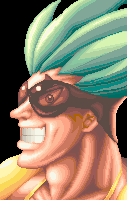
Eagle
Nationality: American
Age: ?
Height: 6′ 7″
Weight: 215 lbs
Hobbies: Pro-wrestling.
The strength-type character is the mysterious American pro-wrestling enthusiast Eagle. His specials are a dashing series of punches and a Blanka-style cannonball roll. Most of his normal attacks are influenced by wrestling moves, giving him a lot of drop-kicks and elbow-drops as well as some nice throws. Oh, and he also uses Hulk Hogan’s famous victory pose.
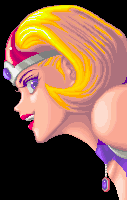
Anne
Nationality: British
Age: 22
Height: 5′ 8″
Weight: 125 lbs
Hobbies: Yoga, cooking.
British warrior Anne is the speedster of the team, using her high mobility to keep away from the enemy. She has a triple fireball, the angle of which can be altered like Kotetsu’s, and a move where she explodes with energy from within, damaging nearby foes. Obviously, her moves are fast and gymnastic.
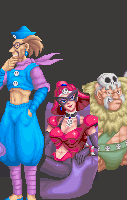
Happy Droppers
The game’s villains. The skinny guy with the glasses is Mr. Chin, the big fella is Garuga and the woman is their leader, Happy. They are quite clearly based on Doronjo, Boyacky and Tonzura, the villains of the anime series Yatterman who are probably most familiar to gamers from their appearance in Tatsunoko vs Capcom.
Once you have selected your character, you choose which monster you get to fight first; once they’re defeated, you then fight the remaining five at random. An interesting thing about the monsters is that some of them are based on enemies from the Gradius series, so if you are a fan of Konami’s most famous shooter series, Monster Maulers might hold that little bit of extra appeal. Two of the stages (Brainy and Moai) also have a smaller boss that must be defeated at the start of the stage. Brainy’s sub-boss is a flying, snake-like collection of organs called Serpent, while Moai’s stage features a carnivorous plant called Spider Wort. Once all of the monsters are destroyed, you head to the Happy Droppers’ ship for the final confrontation, and the game moves away from being a one-on-one fighter to being a side-scrolling brawler for a while.
Monsters
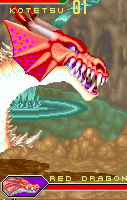
Dragon
A giant dragon, based on the Intruder enemy from Gradius/Salamander. He can change color between red, white and blue, with each colour giving him a different elemental breath attack. He also blocks attacks to the head with his ear-fins, which looks adorable. His stage is a cave in Norway.
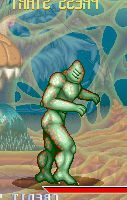
Fungus / Slime
A gooey monster with gills for eyes who lives under the sea. He attacks mostly by bouncing around as a ball and stretching his arms at you, and he can also absorb you into his body and you must mash the buttons to escape. His stage is a very nicely-detailed underwater grotto in Bermuda.
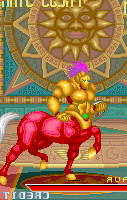
Centaur
A red, armored centaur who attacks with a large bladed yo-yo type weapon, as well as by kicking. You can knock his mask off, like Vega in Street Fighter. His stage is a temple in Iraq.
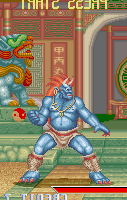
Diablo / Furaiki
A Chinese storm demon who fights a lot like Blanka from Street Fighter. Most of his attacks utilize some kind of elemental power, like his spinning tornado kick. When he’s defeated his body is rather gruesomely pecked apart by a flock of crows. His stage is a pagoda in China.
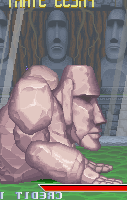
Moai
Konami’s pseudo-mascot, the Moai fights in an underground cave in Brazil. Unlike his other incarnations, he has a torso and arms that he uses to pull himself around, as well as attacking with the Ripple laser from Gradius. His stage music is a remix of “The Old Stone Age” from Gradius II.
Brainy / Brain Golem
A floating brain with tentacles and one bulging eye, Brain Golem is based on the boss of the same name from Salamander. He fights in a gory biological stage in Kenya, using is long arms to keep you at bay while he fires lasers at you. His stage music is a remix of Salamander‘s “Poison of Snake”.
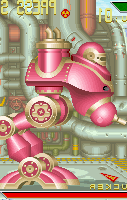
Ducker
Once the first six monsters are defeated, the battle moves aboard the Happy Droppers’ ship. First you’ll fight Mr. Chin, who is piloting the Ducker. Again, the Ducker is based on the enemies of the same name from the Gradius series. It attacks with a flamethrower and by kicking.
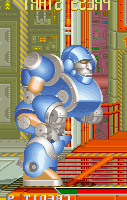
Robo Ape / Mecha Gorilla
Next up you fight Gargua, who is piloting a giant robot gorilla, the face of which is somewhat reminiscent of the Sentinels from the ’90s X-Men cartoon. He fights as you would expect a robot gorilla to, with lots of big, swinging punches, as well as missiles.
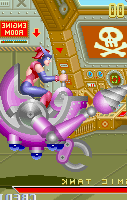
Cosmic Tank / Happy Buster Ace
Happy is the final boss, and she rides around in a pink chair with a drill on the front. She’s the standard posh Japanese female villain, complete with “oh ho ho!” laughter. Once she’s taken enough damage, she starts dropping bombs and teleporting around the stage. Beat her, and it’s the end of the game.
Monster Maulers‘ gameplay lies somewhere between a standard one-on-one fighter like Street Fighter II and a scrolling beat-em-up. Most of the game is focused on one-on-one battles with large boss enemies, with the fighting restricted to one plane, although there are some scrolling stages where you must defeat some smaller enemies before the main battle. The control system is simple and intuitive: there are buttons for light, medium and hard attack, holding up makes you jump, down to crouch and back to block. It’s a system that’ll be familiar to anybody that has played almost any beat-em-up in the past two decades. Each character also has two special moves, performed in the standard manner by using joystick motions plus a button, and when playing in two-player mode both players can join together to launch a super attack.
Graphically, Monster Maulers is up there with some of Konami’s best games of the period. The characters all have large, well-animated sprites, colored in fairly unique, almost pastel colour schemes. The backgrounds, while not as hugely detailed as some arcade titles, are well rendered and have some very nice elements, particularly Slime’s stage and its giant coelacanth. The enemies visibly take damage (for example, you can destroy Brain Golem’s eyeball,) which is always a welcome touch. One particularly pleasing element is that unlike Final Fight, for example, where each character has a standard ground combo, a jumping attack and a special that feel fairly uniform, the characters in Monster Maulers are designed and animated in such a way that each they feel unique, with a great sense of the characters being very different and having their own fighting style, with (for example) Kotetsu’s accurate martial-arts moves feeling very different from Eagle’s powerful strikes.
The music is one of the game’s strongest assets. If you’ve ever watched a fighting or giant-robot anime, or seen a Super Sentai show, the music will seem instantly familiar, and even if you haven’t they’re still as good a collection of dynamic action themes as you’re likely to find in any arcade game of the time. The vocal theme “Tatakae! Dadandarn!” in particular is a spot-on homage to hyper-dramatic anime theme songs, and it makes it obvious that the creators of Monster Maulers had a huge amount of affection for the subject matter that inspired the game. Add in the Gradius remixes, which fit in very well despite being in a somewhat different style, and it makes for a great soundtrack. The composer, Yoshihiko Koezuka, sadly didn’t provide the soundtrack for any other “standard” arcade titles, although he did go on to work on many of the GuitarFreaks games.
Of course, the graphics and sound don’t mean anything if the gameplay isn’t very good, but Monster Maulers delivers in that regard too. The controls are responsive and intuitive, striking a good balance between simplicity and complexity. The action is fast-paced, with characters leaping through the air, bouncing off walls and sliding along the floor as they dish out fist-based justice to their enemies. Attacks often seem to link into each other in a very satisfying and smooth manner, and there’s a good variety of air combos and throws. Your opponents are great fun to fight against: they can be a challenge, but the game never seems unfair or like it’s been designed solely to rip the coins from your pocket. One criticism that could perhaps be leveled at Monster Maulers is that final stage and the Happy Droppers aren’t as interesting as the rest of the game, with the final boss being something of a let-down after fighting a Moai and a flying brain. Monster Maulers does feature alternate endings, but the conditions required to activate them are difficult to determine. The content of the ending scenes seems to be affected by the number of continues used and the amount of visible damage you do to the bosses (for example knocking off Centaur’s mask), but the exact conditions for the different endings seem inconsistent: it’s possible to get the “bad” ending after completing the game without using a continue, and possible to get the “good” ending without damaging all the monsters.
Monster Maulers is sadly almost completely forgotten these days, probably because of a limited release in the arcades as well as its deeply Japanese subject matter. While it didn’t become a television show, there was a two-volume manga based on the game, published by Gamest Comics.
It doesn’t deserve to its unknown status, though: it’s a blast of pure arcade fun, made with an obvious love for the setting and themes, in a style that you don’t see anymore. If you like arcade fighters and you feel like you’ve been through all the classics a hundred times, give Monster Maulers a go; you won’t be disappointed.
